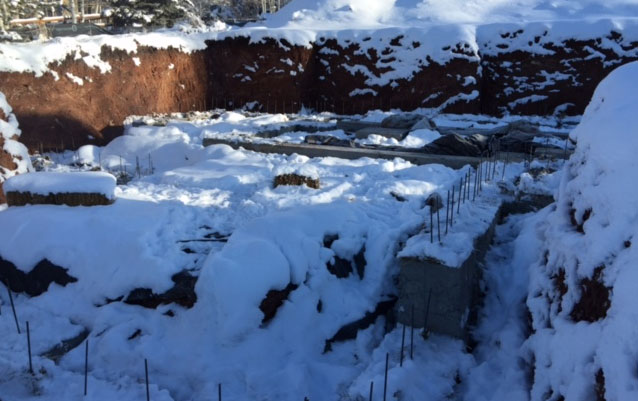This Christmas Miracle May Not Turn Out So Merry
It was 7 AM on Christmas Eve and our 2 1/2 year old yells at the front window, “There goes Cement Mixer Melvin!”. Cement Mixer Melvin is a cement mixer from one of his books. We dismissed his comment and admired his creativity. It was 12 degrees outside after all. Who would pour concrete when it was that cold? We thought, “now that would be a miracle.” Less than 5 minutes later the cement mixer came around the block again and we saw it with our own eyes.
An hour later we headed down the street and saw that indeed they were pouring concrete. Granted, it was now a balmy 14 degrees. At that point we figured maybe we didn’t really know much about concrete. Perhaps the practice is normal? We usually like to stay out of other people’s business but we were worried that that this house will likely be sold to some person this spring and they will have no idea about this (if it truly is a problem). So, we decided to call the Summit County Building Office and ask if there were any development codes related to the temperature at which concrete can be poured. The very helpful gentlemen said that concrete temperature was a procedural matter and it was really up to the discretion of the contractor. He pointed us to the American Concrete Institute and said they had good guidelines. He left us with a very apropos comment. He said his dad did concrete for many years and that it was one of the hardest things to do. He concluded that concrete that was done well is great; concrete that isn’t will turn into a nightmare.
So, it sounds that “legally” concrete could be poured at minus 30. However what does the American Concrete Institute (ACI) recommend? Here is their recommended table:
We read about the ACI guidelines and the problem is we could never find any recommendations for what to do when the temperature was that low. These are some of our observations:
- The ground should be above 32º F when the concrete is poured, or there could be a freezing layer of concrete that doesn’t set well against the ground.
- If there will be a thaw and refreeze, concrete with higher psi (tensile strength) is required.
- Favorable temperates are needed while the concrete cures and the time it needs to cure is impacted by the temperature (colder temps require longer curing).
- Protect from early age freezing.
So, what were the temperatures since the 24th:
24th – Low: 8º / High: 37º
25th – Low 18º / High: 34º
26th – Low 9º / High: 27º
27th – Low -1º / High: 29º
28th – Low 12º / High: 26º
We don’t see any 40º temperatures. We do see a negative temp. We also see some freezing and thawing. All in all, it looks cold.
What does all that mean? We’re concerned that the foundation that was poured on that cold Christmas Eve and continued to cure through freezing temperatures may not end up being sound. However, we don’t know all the details and aren’t experts in concrete. Perhaps a “new fangled” cold temperature concrete was used. Perhaps they had heated all the dirt to over 32º. Who knows?
What we do know is that if you are buying a newly constructed house this spring in Jeremy Ranch, you may want to ask a few questions about how it was constructed. More importantly you may want to have your inspector take a hard look at the foundation and then ask a few more questions.



Comments
Leave a Comment